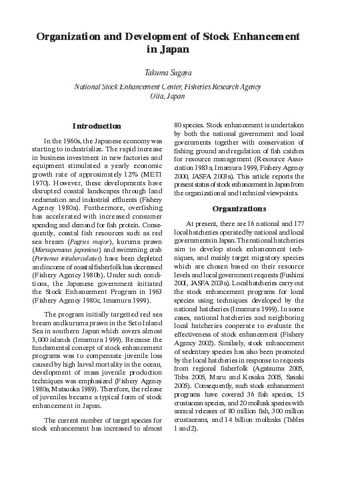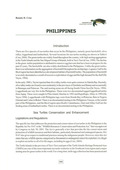Potential of Artificial Reefs for Enhancement of Fisheries Resources - Case Study from Japan
Share
Abstract
The study detail the functions of nurtured bait creatures around shell covered stock enhancement structures in shallow waters of Seto inland sea. In addition it shows the correlation between bait creatures and aggregation of fish. Moreover, the result of a stock assessment study conducted on an artificial reef set in relatively deeper waters of Yamagata prefecture is also presented.
Suggested Citation
Ito, Y., & Terashima, H. (2005). Potential of artificial reefs for enhancement of fisheries resources - Case study from Japan. In Proceedings of the 2nd Regional Workshop on Enhancing Coastal Resources: Artificial Reefs in Southeast Asia, 9-12 November, 2004, Thailand (pp. 145-158). Samut Prakan, Thailand: Training Department, Southeast Asian Fisheries Development Center.
Subject
Related items
Showing items related by title, author, creator and subject.
-
Thailand's concerns in endangered species and stock enhancement
Chaengkij, Marnop (Aquaculture Department, Southeast Asian Fisheries Development Center, 2006)The paper provides a comprehensive list of endangered freshwater, brackishwater, and marine aquatic species in Thailand. The Thai Department of Fisheries is breeding some of the endangered species under the “Rehabilitation ... -
Organization and development of stock enhancement in Japan
Sugaya, Takuma (Aquaculture Department, Southeast Asian Fisheries Development Center, 2006)In the 1960s, the Japanese economy was starting to industrialize. The rapid increase in business investment in new factories and equipment stimulated a yearly economic growth rate of approximately 12% (METI 1970). However, ... -
Philippines
Cruz, Renato D. (Marine Fishery Resources Development and Management Department, Southeast Asian Fisheries Development Center, 2004)There are five species of sea turtles that occur in the Philippines, namely green hawksbill, olive ridley, loggerhead and leatherback. Several locations for sea turtles nesting are shown in Table 6 (Cruz, 2004). The green ...





